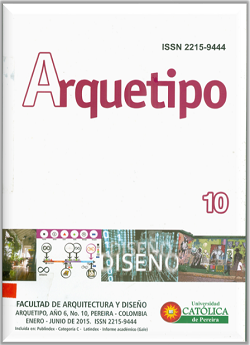The domestic Spanish American courtyard
Keywords:
Domestic space, courtyard, hearth, houseAbstract
This text presents an analytical description of the origin and most representative symbolic aspects of the colonial house established by the Spanish in America during the continent’s colonization based on the architectural type of articulating courtyard. It highlights the numinous character of the mental structure of the Spanish American patio house, established after the symbolic vertical connection between hearth and heaven as divine place.
References
Argán, G. (1969). Proyecto y destino. Caracas: Universidad Central.
Arregui, J. y Jacinto Choza (1993). Filosofía del hombre. Madrid: Rialp.
Bachelard, G. (1993). La poética del espacio. México: Fondo de Cultura Económica
Capitel, A. (2005). La arquitectura del patio. Barcelona: Gustavo Gili.
Cordovez, J. (1962). Reminiscencias de Santafé y Bogotá. Madrid: Aguilar de Certeau, M. (1999). La invención de lo cotidiano II. Habitar, cocinar. México: Universidad Iberoamericana / Instituto Tecnológico y de Estudios Superiores de Occidente.
Deleuze, G. y Félix Guattari (1994). Mil mesetas. Valencia: Pre-textos.
Duque, F. (2008). Habitar la tierra. Madrid: Abarra.
Eliade, M. (1992). Lo sagrado y lo profano. Barcelona: Labo.
Jung, C. et al. (1969). El hombre y sus símbolos. Madrid: Aguilar.
Jung, C. (1990). Formaciones de lo inconsciente. Barcelona: Paidós.
Jung, C. (1994). Arquetipos e inconsciente colectivo. Barcelona: Paidós
Leroi-Gourhan, A. (1971). El gesto y la palabra. Caracas: Universidad Central.
Martí, C. (1993). Las variaciones de la identidad. Barcelona: Serbal.
Pardo, J. (1992). Las formas de la exterioridad. Valencia: Pre-textos.
Rapoport, A. (1969). Vivienda y cultura: Barcelona: Gustavo Gili.

